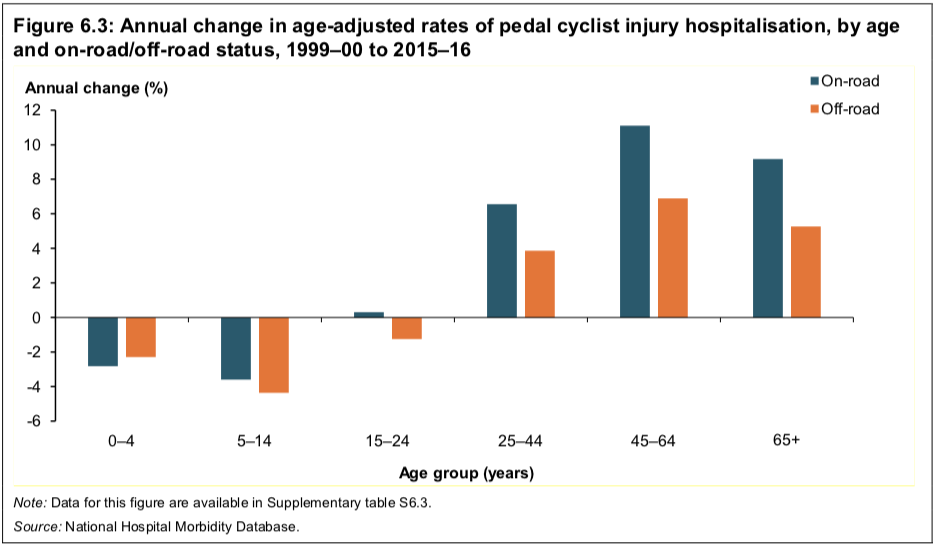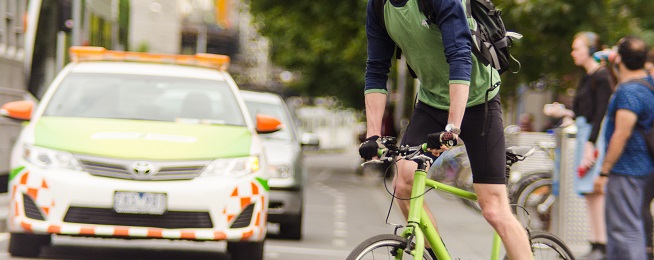The good news is that older people are riding bikes more to stay active and healthy. The bad news is that they are crashing their way into hospitals at a growing rate.
A new analysis of hospital data going back 17 years shows that there is a marked increase in the rate of hospitalisation of riders at older ages.
Since about 2001 there has also been a large increase in bike riding among older adults, so more crashes would be expected.
But the research shows that older riders are not only crashing more, they have more severe injuries: compared with riders under 45, riders over 45 were more likely to have life threatening injuries, and stayed longer in hospital.
The report, undertaken by the Australian Institute of Health and Welfare and Flinders University, looked at fatalities and hospitalisations of bike riders between 1999-2000 and 2015-2016.
It showed that over a 17 year period, during which cycling by adults increased, nearly 160,000 cyclists were hospitalised, and the rate of hospitalisations has risen an average of 1.5% each year over this period.
Other findings include:
- Nine in ten of the rider fatalities were men.
- 90 per cent of fatal incidents occurred on the road
- While injuries to other road users are declining, injuries to bike riders are increasing.
- Nearly six in ten riders who are hospitalised suffered fractures, and six in ten fractures are of the upper limbs
- Fifty-eight per cent of the hospitalisation crashes did not involve a collision but were crashes such as falls
- Five per cent of collisions were with another bike
- Twenty-three per cent of on-road crashes resulting in hospitalisation were with the driver of a motor vehicle.
Co-author of the paper, Prof James Harrison said that the severity of injuries sustained by riders generally increased with age.
"Those aged 45 and over were more likely to have life-threatening injuries, stay longer in hospital and be transferred to another hospital.’
"Cyclists aged 45 or older consumed 90% of the total hours of ventilator support, with more than half provided to those aged 45–64," Professor Harrison said.
"According to the ABS, in 2017 people aged 65 and over made up 15% of the Australian population. By 2066, this proportion is expected to rise to 21%–23% (ABS 2018). So, it can be expected that, over coming decades, the costs associated with the hospitalisation of older cyclists will grow markedly,” the report says.
The result in the report should be assessed again st the background of rapidly increasing numbers of people riding bikes. A survey conducted by the Australian Sports Commission shows that the number of cyclists aged 15 and over rose by 45% between 2001 and 2010, from 1.4 million to 2.1 million.
While rate of injury appears to be increasing Bicycle Network CEO Craig Richards said it's important to remember that riding a bike is not an inherently dangerous activity.
"The risk of having a crash when riding a bike is still extremely low,” Mr Richards said.
“However, it’s not good enough that serious injuries and deaths for bike riders is not improving when it is for other road users. More must and can be done.”
“If we’re to solve our inactivity and congestion crisis, we need more people riding bikes. We have to do more to look after those riding and make those wanting to ride feel comfortable.”
“The blueprint for Australian cities and towns should be dedicated bike lanes, reduced speed limits, safer vehicles and laws that prioritise and protect people who ride.”


Become our friend
Find out more about Bicycle Network and support us in making it easier for people to ride bikes.


